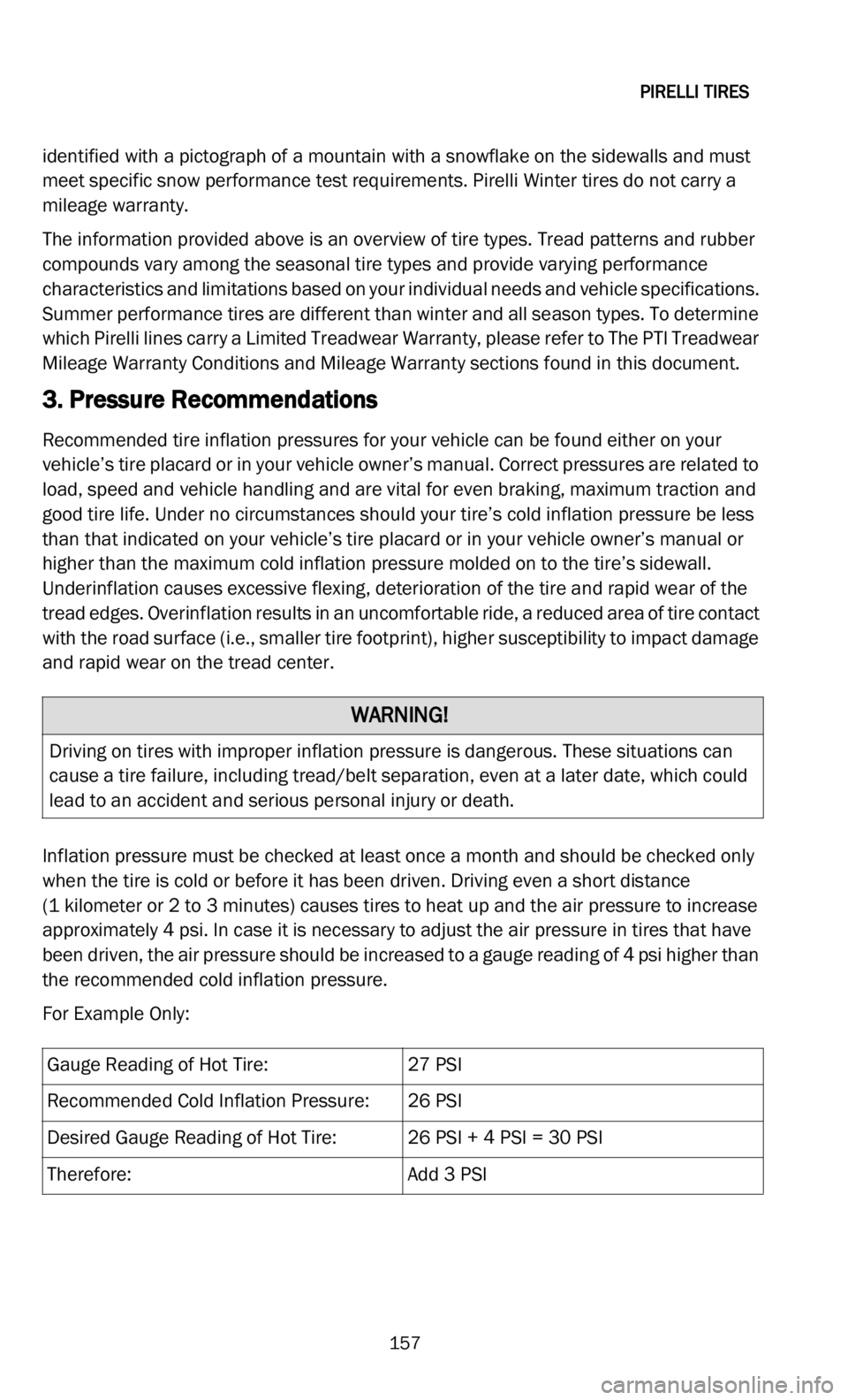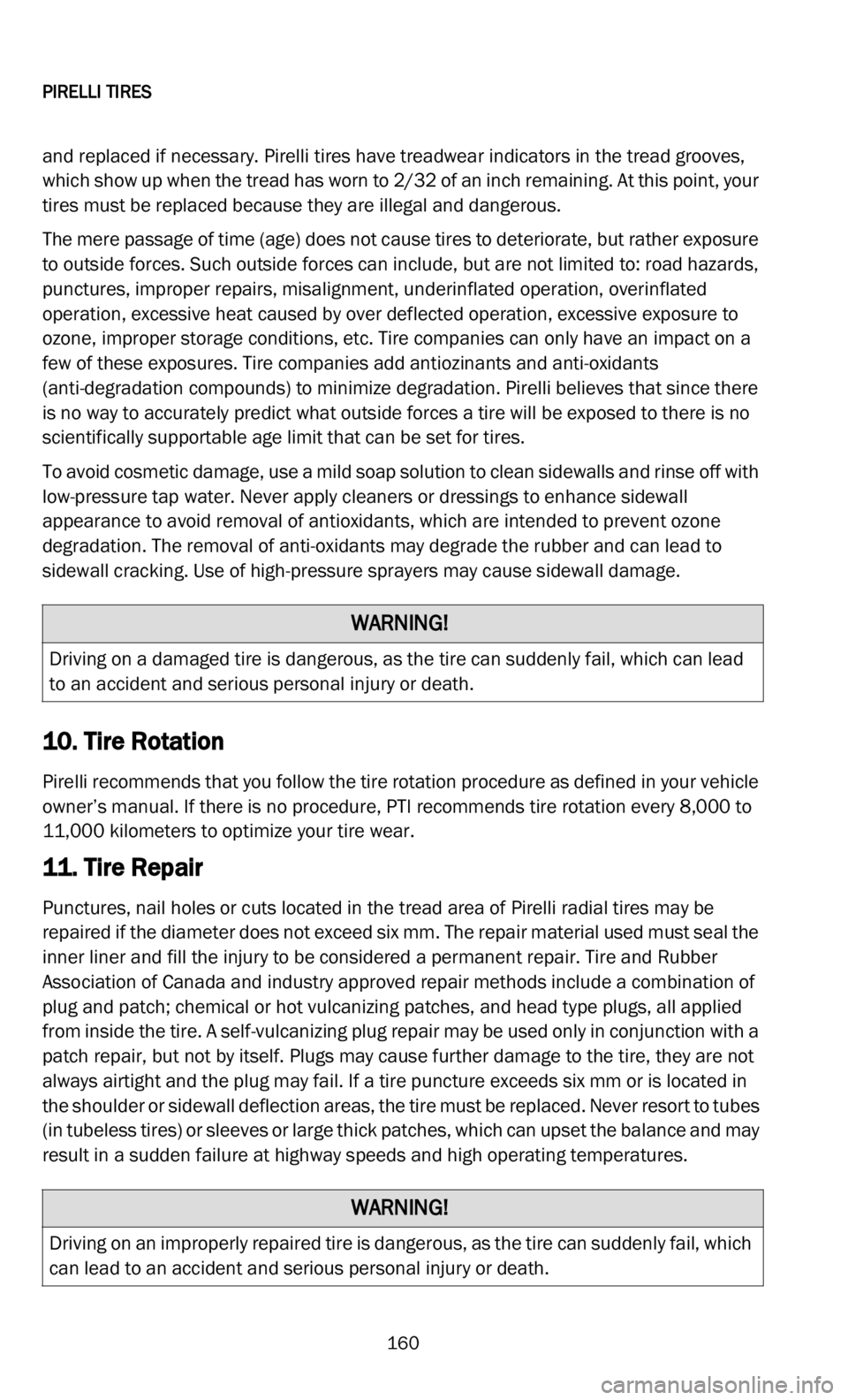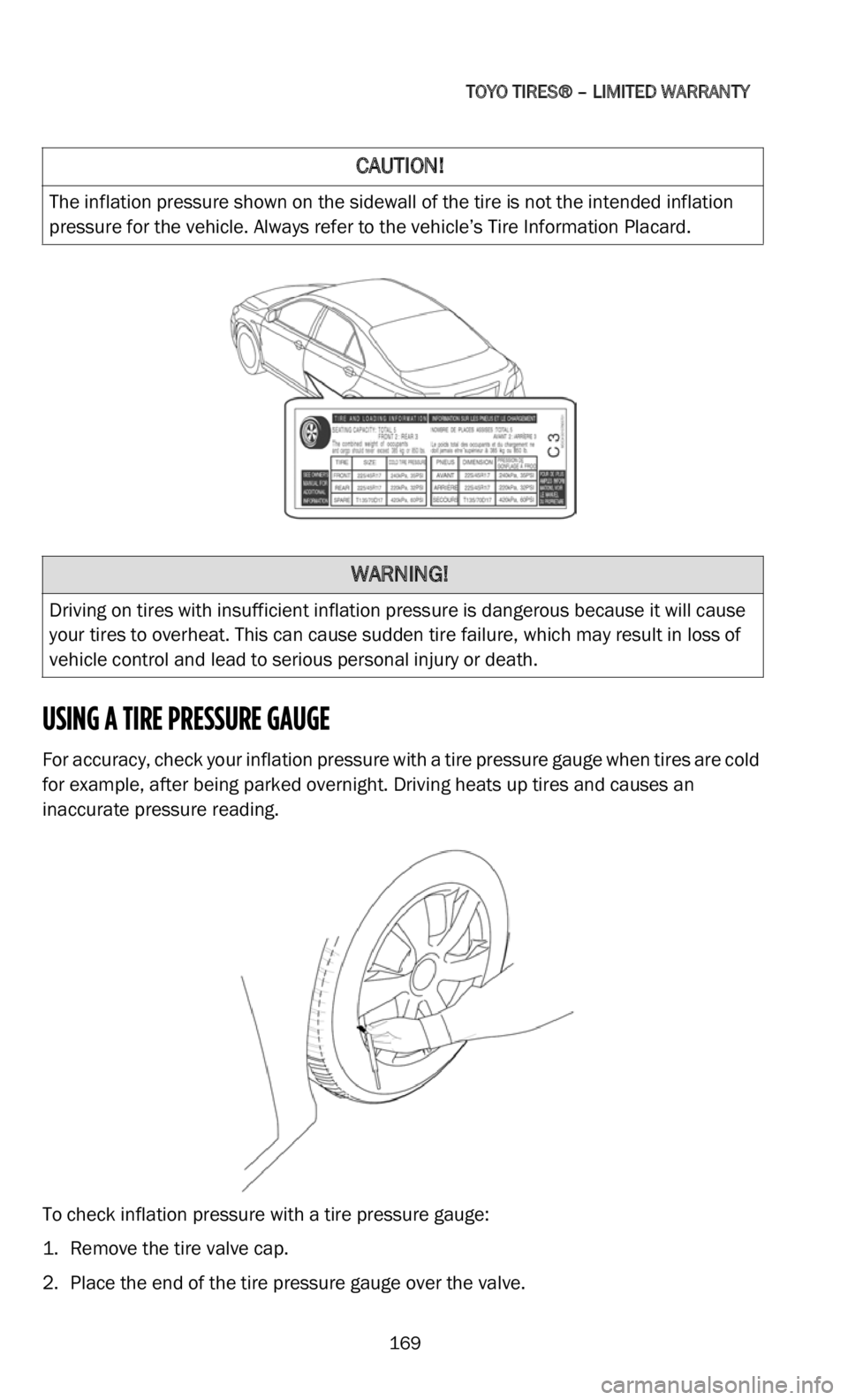warning DODGE DURANGO 2022 Vehicle Warranty
[x] Cancel search | Manufacturer: DODGE, Model Year: 2022, Model line: DURANGO, Model: DODGE DURANGO 2022Pages: 200, PDF Size: 6.72 MB
Page 124 of 200

MICHELIN®
123
CONDITIONS AND EXCLUSIONS
This limited warranty does not provide compensation for loss of time, loss of use of
vehicle, inconvenience or incidental or consequential damages. Tires presented for
claim remain the property of the consumer and Michelin® accepts no responsibility for
loss or damage to tires which are in the custody or control of a Michelin® tire retailer for
the purpose of inspection for warranty adjustment.
In the event of a disputed claim, the consumer must make the tire available for further
in
spection.
Tires accepted for claim become the property of Michelin® North America, Inc.
No Michelin® representative, employee or retailer has the authority to make or imply any
re
presentation, promise or agreement, which in any way varies from the terms of this
warranty.
This warranty applies only in the United States and Canada.
SAFETY MAINTENANCE INFORMATION
Read your Tire Owner’s Manual, the information on the sidewall of your tires, your vehicle
Owner’s Manual and vehicle tire information placard for essential safety and
maintenance information. When service is required:
1. C ontact a participating Michelin® tire retailer listed in your local yellow pages.
2
. I f additional assistance in locating a participating Michelin® tire retailer is required,
p
lease call the phone number listed in this book for the Consumer Care Department
in your area.
ARBITRATION CLAUSE
RESOLUTION OF DISPUTES
ALL CLAIMS ARISING FROM THIS LIMITED WARRANTY OR THE MARKETING, SALE OR
P E
RFORMANCE OF THE PURCHASED PRODUCT AGAINST MICHELIN® NORTH AMERICA,
INC. AND ITS AGENTS, EMPLOYEES, DEALERS, AFFILIATES, PARENT OR SISTER
CORPORATIONS, RELATED CORPORATE ENTITIES, PREDECESSORS, SUCCESSORS OR
ASSIGNS (HEREINAFTER COLLECTIVELY “MICHELIN®”) SHALL BE SUBJECT TO BINDING
ARBITRATION. You and Michelin® acknowledge your and its right to litigate claims,
disputes and controversies arising out of or in connection with this limited warranty or
the marketing, sale or performance of the purchased product in court, but prefer to
resolve any such claims, disputes and controversies through arbitration and hereby
waive the right to litigate such claims, disputes and controversies in court upon election
of arbitration by either party. Therefore, you and Michelin® agree that all claims,
disputes, and controversies between you and Michelin® arising out of or in connection
WARNING!
DISREGARDING ANY OF THE SAFETY PRECAUTIONS AND INSTRUCTIONS CONTAINED
IN THIS MANUAL MAY RESULT IN TIRE FAILURE OR EXPLOSION CAUSING SERIOUS
PERSONAL INJURY OR DEATH.
Page 125 of 200

MICHELIN®
124
with this limited warranty, or any other warranties, express or implied, including a failure
of warranty, or any claims arising out of or in connection with the marketing, sale or
performance of the purchased product, including but not limited to claims for consumer
fraud or brought under any consumer protection statute, but excluding claims for
personal injury or property damage, shall be finally resolved solely by arbitration, upon
election by either party, according to the formal dispute resolution procedures then in
effect of the National Arbitration Forum, or if the National Arbitration Forum is no longer
conducting such arbitrations, a successor organization thereto or such other private
arbitration service as you and Michelin® North America, Inc. shall mutually agree (the
actual authority involved, the “Arbitral Body”). The Arbitral Body shall decide the issues
submitted in accordance herewith, provided that all substantive questions of law will be
determined under the laws of the State in which you purchased the product at issue. You
agree that no claim subject to arbitration shall be arbitrated as a class action, or on a
class-wide or representative basis, or on behalf of the general public, or on behalf of
other persons that may be similarly situated. You agree that you do not have the right to
act as a private attorney general, a class representative, or to participate as a member
of a class of claimants with any claim subject to arbitration. You further agree that no
claim subject to arbitration shall be heard by a jury and that any judgment or award of
the Arbitral Body will be final and not subject to judicial review. All arbitrations will be
conducted as document hearings. Each party shall bear its own costs arising from and
associated with the document hearing with MICHELIN® the exception of the arbitrator’s
fee which will be borne by all parties in equal shares. If either party requests any
procedures beyond a document hearing, the requesting party will be responsible for all
fees, including filing and administrative fees, above and beyond the fees required for
document hearings. Any award of the arbitrator(s) may be entered as a judgment and
shall be enforceable in any court of competent jurisdiction. The arbitrators will have no
authority to award punitive or other damages not measured by the prevailing party’s
actual damages, except as may be required by statute. Information about arbitration may
be obtained and claims may be filed at any office of the National Arbitration Forum or at
P.O. Box 50191, Minneapolis, MN 55405.
TIRE DISABLEMENT
SAFETY WARNING
Any tire may fail as a result of an improperly repaired puncture, impact damage, improper
in
flation, overloading or other conditions resulting from use or misuse. Tire failures, such
as a rapid air loss or a tread and belt detachment, may increase risk of injury or death
and/or property damage. To reduce the risk of a tire failure, Michelin® recommends you
thoroughly read and follow the recommendations in the Michelin® Owner’s Manual,
vehicle Owner’s Manual, tire placard information, and tire sidewall information regarding
safety warnings, proper tire use and maintenance.
CONTROLLABILITY
Controlling a vehicle when a tire failure occurs
If a tire failure occurs, you may hear a loud noise, feel a vibration, and/or the vehicle may
p u
ll toward the side of the failed tire. If possible, step on the accelerator momentarily to
maintain forward momentum and ensure vehicle control. It is most important that you
Page 126 of 200

MICHELIN®
125
DO NOT BRAKE OR ABRUPTLY TURN THE STEERING WHEEL. Slowly remove your foot
from the accelerator and hold the steering wheel firmly while steering to remain in your
lane. Once the vehicle has slowed and is fully under control, apply the brakes gently;
safely pull over to the shoulder and come to a stop. Inspect the tires. If one or more looks
flat or low, shows detachment or other damage, remove tire assembly and replace it with
a properly inflated spare. Bumps or bulges may indicate detachment within the tire body
and require inspection by a qualified tire technician.
DRIVING ON ANY TIRE THAT DOES NOT HAVE THE CORRECT INFLATION PRESSURE
IS DANGEROUS
Any underinflated tire builds up excessive heat that may result in sudden tire destruction.
If tires are supplied as original equipment, refer to the tire decal on the vehicle (check
vehicle and/or vehicle Owner’s Manual for decal location) for the recommended
operating pressures. For replacement tires, the correct inflation pressure will be provided
by your tire retailer; if not, refer to the vehicle decal.
These inflation pressures must be maintained as a minimum. However, do not exceed
th
e maximum pressure rating indicated on the tire sidewall.
SELF-SUPPORTING TIRES. ZERO PRESSURE (ZP) TIRES, AND PAX® SYSTEM TIRES, AT
LO W
OR ZERO AIR PRESSURE
The handling characteristics of a vehicle with a deflated PAX® System tire or Self-
S u
pporting Zero Pressure (ZP) tire (whether front or rear) are not the same as those of a
vehicle with normally inflated tires. Avoid high speeds and hard cornering whenever a low
pressure warning is activated.
Even a MICHELIN® PAX® System Tire or Self-Supporting Zero Pressure (ZP) tire can build
u p
excessive heat when run underinflated for an extended period of time. The length of
time and distance a PAX® System Tire/Self-Supporting Zero Pressure (ZP) tire will
perform at low or zero air pressure will depend upon the severity of the event causing air
loss, ambient temperature, speed at which the tire is operated, and the conditions under
which the tire is operated (i.e. hard braking, cornering and other sharp maneuvers will
greatly reduce the length of time the tire can perform at low or zero air pressure.)
Continuous use of an underinflated tire may lead to sudden tire destruction. If a tire at
low or zero pressure begins to vibrate or cause difficulty in vehicle handling, remove the
tire immediately and replace with the temporary spare. If Michelin® PAX® System Tire/
Self-Supporting Zero Pressure (ZP) tires are supplied as original equipment, refer to the
vehicle owner’s manual for complete details on the low tire pressure warning system
designed to alert you in the event of a low pressure condition.
NOTE:
MICHELIN® SELF-SUPPORTING ZERO PRESSURE (ZP) TIRES ARE TO BE USED ONLY IN
C O
NJUNCTION WITH AN OPERATIONAL, MICHELIN® APPROVED, LOW TIRE PRESSURE
WARNING SYSTEM. Otherwise, all provisions of the limited warranty are void. For a list of
approved systems, see your participating Michelin® tire retailer, or call toll
free:1-800-847-3435
Page 127 of 200

MICHELIN®
126
NOTE:
Some MICHELIN® Self-Supporting Zero Pressure (ZP) tires can only be mounted on
s p
ecial SH-M (Symmetric Hump - Modified) wheels. These tires bear the special SH-M
designation, molded into the sidewall of the tire, next to the ZP designation. DO NOT
MOUNT A TIRE WITH THE SH-M DESIGNATION ON THE SIDEWALL ON A STANDARD
WHEEL. DOING SO VOIDS THIS LIMITED WARRANTY AND COULD CAUSE THE TIRE TO
BECOME UNSERVICEABLE AT LOW OR ZERO PRESSURE, RESULTING IN SERIOUS
PERSONAL INJURY OR DEATH.
NOTE:
MICHELIN® PAX® SYSTEM TIRES ARE TO BE USED ONLY IN CONJUNCTION WITH AN
O P
ERATIONAL, TIRE PRESSURE MONITORING SYSTEM (TPMS), APPROVED BY THE
VEHICLE MANUFACTURER FOR USE WITH THE PAX® SYSTEM. Otherwise, all provisions
of the limited warranty are void. For a list of approved systems, see an authorized PAX®
System retailer, or call toll free: 1-877-PAX TIRE or 1-877-729-8473
For all types of tires, consult your vehicle tire placard or owner’s manual for
r e
commended operating pressures. If the tires are purchased as replacement tires,
operating instructions for the low pressure warning system will be provided by the
manufacturer of that system. Recommended operating pressures will be provided by a
participating Michelin® tire retailer for self supporting ZP tires. Recommended operating
pressure for PAX® System Tires will be provided by a PAX® System retailer. These
inflation pressures must be maintained as a minimum. However, do not exceed the
maximum pressure rating indicated on the tire sidewall.
CHECK THE COLD INFLATION PRESSURES IN ALL YOUR TIRES, INCLUDING THE SPARE,
A T
LEAST ONCE EACH MONTH
Failure to maintain correct inflation may result in improper vehicle handling and may
c a
use rapid and irregular tire wear, sudden tire destruction, loss of vehicle control and
serious personal injury. Therefore, inflation pressures should be checked at least once
each month and always prior to long distance trips. This applies to all tires, including
sealant types, and Self-Supporting Zero Pressure (ZP) tires which are as susceptible to
losing air pressure as any other type of tire if not properly maintained.
UNDERINFLATION
It is impossible to determine whether tires are properly inflated by simply looking at them.
It is almost impossible to “feel or hear” when a tire is being run underinflated or nearly
flat. Tires must be checked monthly with a tire pressure gauge.
Pressures should be checked when tires are cold, in other words, before they have been
d r
iven on. Driving, even for a short distance, causes tires to heat up and air pressure to
increase.
Checking pressure when tires are hot:
If pressures are checked after tires have been driven for more than three minutes or
m o
re than 1 mile, (2 km) the tires become hot and the pressures will increase by
a p
proximately 4 psi. Therefore when the tire pressure is adjusted under these
conditions, it should be increased to a gauge reading of 4 psi greater than the
recommended cold inflation pressure.
Page 128 of 200

MICHELIN®
127
For Example Only:
• G auge reading of hot tire:.................................................. 32 psi (220 kPa)
•
If recommended cold inflation pressure is: ..................... 30 psi (205 kPa)
•
Desired gauge reading of hot tire 30 + 4 psi =................ 34 psi (205 + 30 = 235 kPa)
•
Therefore: add 2 psi........................................................... (15 kPa)
C
heck cold pressure as soon as possible, preferably within 24 hours. “Bleeding” air from
h o
t tires could result in underinflation. Use an accurate tire gauge to check pressures.
Never allow children to inflate or deflate tires.
FOR MICHELIN® PAX® SYSTEM TIRES/SELF-SUPPORTING ZERO PRESSURE (ZP) TIRES
C H
ECK INFLATION PRESSURES AS SOON AS POSSIBLE FOLLOWING A LOW PRESSURE
WARNING
The PAX® System requires a functioning, correctly calibrated on-board vehicle tire
p r
essure monitoring system (TPMS) to monitor the air pressure and alert the driver when
a low pressure event occurs. Be certain to ensure that your vehicle’s TPMS is functioning
and is correctly calibrated. Refer to your vehicle Owner’s Manual or your vehicle dealer.
Low pressure warning systems are designed to alert the driver to a low air pressure
s i
tuation in at least one tire on the vehicle. While your ZP tires are designed to provide
continued mobility in the event of an air loss, the sooner you respond to a warning and
take corrective action, the greater the likelihood that the tire can be returned to service.
Always visually inspect your MICHELIN® PAX® System tire and self-supporting tires and
u s
e a pressure gauge to check the air pressure in all four tires following any low pressure
warning. (Unless advised to do otherwise by the manufacturer of your low pressure
warning system.)
If the tire pressure is at or below 18 PSI, proceed to the nearest Authorized PAX® System
R e
tailer for PAX® tires or a participating Michelin® tire retailer for ZP tires or a
representative of your vehicle manufacturer if advised to do so in your vehicle Owner’s
Manual and have the tire demounted and thoroughly inspected for possible internal
damage.
If you are unable to see any damage to the tire, and the tire pressure is more than
18 PSI, reinflate your tire to the proper air pressure. See instructions for checking
p r
essures when tires are hot. When tires have cooled, check air pressure again. If any
tire has lost more than 5 PSI from the previous pressure check, have the tire inspected
at once by an authorized PAX® System Retailer for PAX® tires or a participating
Michelin® tire retailer or representative of your vehicle manufacturer if your vehicle
Owner’s Manual so advises. Failure to do so may cause irreparable damage to the tire
and result in sudden tire destruction and personal injury.
TIRE PRESSURE MONITORING SYSTEMS (TPMS):
Your vehicle may be equipped with a Tire Pressure Monitoring System (TPMS) that is
designed to monitor the pressure of tires mounted on your vehicle and sends a signal to
the driver if a tire pressure falls below a predetermined level. A TPMS should not replace
monthly manual pressure checks for all four tires and the spare. We recommend that you
manually monitor and check tire pressure inflation with a pressure gauge. Your tires
Page 132 of 200

MICHELIN®
131
misalignment of your vehicle. When driving on such roads, drive carefully and slowly, and
before driving again at normal or highway speeds, examine your tires for any damage,
such as cuts, bulges, penetrations, unusual wear patterns, etc.
WEAR-BARS
Michelin® tires contain “Wear-Bars” in the grooves of the tire tread which show up when
o n
ly 2/32 of an inch (1.6 mm) of tread is remaining. At this stage, your tires must be
r e
placed. Tires worn beyond this stage are extremely dangerous.
DO NOT OVERLOAD - DRIVING ON ANY OVERLOADED TIRE IS DANGEROUS
The maximum load rating of your tires is molded on the tire sidewall. Do not exceed this
rating. Follow the loading instructions of FCA US LLC for your vehicle and this will ensure
that your tires are not overloaded. Tires which are loaded beyond their maximum
allowable loads for the particular application will build up excessive heat that may result
in sudden tire destruction.
Do not exceed the gross axle weight rating for any axle on your vehicle.
TRAILER TOWING
If you anticipate towing a trailer, you should visit any Michelin® tire retailer for advice
c o
ncerning the correct size tire and pressures. Tire size and pressures will depend upon
the type and size of trailer and hitch utilized, but in no case must the maximum cold
inflation pressure or tire load rating be exceeded. Check the tire decal and the owner’s
manual supplied by FCA US LLC for your vehicle for further recommendations on trailer
towing.
MICHELIN® PAX® System Tires/Self-Supporting Zero Pressure (ZP) Tires and Trailer
T o
wing
Operation of Pax® or ZP tires at low or zero air pressure with a trailer in tow, is dangerous
a n
d is not recommended. If the low pressure warning indicator is activated when a trailer
is in tow, stop, disconnect the trailer, and do not continue to tow the trailer until the tire
has been repaired and re-inflated to the proper air pressure. If the tire cannot be
repaired, it must be replaced with a new full size, PAX®/ZP tire, and inflated to the proper
air pressure, before the trailer can be safely towed again.
WHEEL ALIGNMENT AND BALANCING ARE IMPORTANT FOR SAFETY AND MAXIMUM
M I
LEAGE FROM YOUR TIRES.
CHECK HOW YOUR TIRES ARE WEARING AT LEAST ONCE EACH MONTH
If your tires are wearing unevenly, such as the inside shoulder of the tire wearing faster
th
an the rest of the tread, or if you detect excessive vibration, your vehicle may be out of
alignment or balance. These conditions not only shorten the life of your tires but
adversely affect the handling characteristics of your vehicle, which could be dangerous.
If you detect irregular wear or vibration, have your alignment and balance checked
immediately. Tires which have been ran underinflated will show more wear on the
shoulders than in the center of the tread.
Page 158 of 200

PIRELLI TIRES
157
identified with a pictograph of a mountain with a snowflake on the sidewalls and must
meet specific snow performance test requirements. Pirelli Winter tires do not carry a
mileage warranty.
The information provided above is an overview of tire types. Tread patterns and rubber
c o
mpounds vary among the seasonal tire types and provide varying performance
characteristics and limitations based on your individual needs and vehicle specifications.
Summer performance tires are different than winter and all season types. To determine
which Pirelli lines carry a Limited Treadwear Warranty, please refer to The PTI Treadwear
Mileage Warranty Conditions and Mileage Warranty sections found in this document.
3. Pressure Recommendations
Recommended tire inflation pressures for your vehicle can be found either on your
vehicle’s tire placard or in your vehicle owner’s manual. Correct pressures are related to
load, speed and vehicle handling and are vital for even braking, maximum traction and
good tire life. Under no circumstances should your tire’s cold inflation pressure be less
than that indicated on your vehicle’s tire placard or in your vehicle owner’s manual or
higher than the maximum cold inflation pressure molded on to the tire’s sidewall.
Underinflation causes excessive flexing, deterioration of the tire and rapid wear of the
tread edges. Overinflation results in an uncomfortable ride, a reduced area of tire contact
with the road surface (i.e., smaller tire footprint), higher susceptibility to impact damage
and rapid wear on the tread center.
Inflation pressure must be checked at least once a month and should be checked only
w h
en the tire is cold or before it has been driven. Driving even a short distance
(1 kilometer or 2 to 3 minutes) causes tires to heat up and the air pressure to increase
a p
proximately 4 psi. In case it is necessary to adjust the air pressure in tires that have
been driven, the air pressure should be increased to a gauge reading of 4 psi higher than
the recommended cold inflation pressure.
For Example Only:
WARNING!
Driving on tires with improper inflation pressure is dangerous. These situations can
cause a tire failure, including tread/belt separation, even at a later date, which could
lead to an accident and serious personal injury or death.
Gauge Reading of Hot Tire: 27 PSI
Recommended Cold Inflation Pressure: 26 PSI
Desired Gauge Reading of Hot Tire: 26 PSI + 4 PSI = 30 PSI
Therefore: Add 3 PSI
Page 161 of 200

PIRELLI TIRES
160
and replaced if necessary. Pirelli tires have treadwear indicators in the tread grooves,
which show up when the tread has worn to 2/32 of an inch remaining. At this point, your
tires must be replaced because they are illegal and dangerous.
The mere passage of time (age) does not cause tires to deteriorate, but rather exposure
to
outside forces. Such outside forces can include, but are not limited to: road hazards,
punctures, improper repairs, misalignment, underinflated operation, overinflated
operation, excessive heat caused by over deflected operation, excessive exposure to
ozone, improper storage conditions, etc. Tire companies can only have an impact on a
few of these exposures. Tire companies add antiozinants and anti-oxidants
(anti-degradation compounds) to minimize degradation. Pirelli believes that since there
is no way to accurately predict what outside forces a tire will be exposed to there is no
scientifically supportable age limit that can be set for tires.
To avoid cosmetic damage, use a mild soap solution to clean sidewalls and rinse off with
l o
w-pressure tap water. Never apply cleaners or dressings to enhance sidewall
appearance to avoid removal of antioxidants, which are intended to prevent ozone
degradation. The removal of anti-oxidants may degrade the rubber and can lead to
sidewall cracking. Use of high-pressure sprayers may cause sidewall damage.
10. Tire Rotation
Pirelli recommends that you follow the tire rotation procedure as defined in your vehicle
owner’s manual. If there is no procedure, PTI recommends tire rotation every 8,000 to
11,000 kilometers to optimize your tire wear.
11. Tire Repair
Punctures, nail holes or cuts located in the tread area of Pirelli radial tires may be
repaired if the diameter does not exceed six mm. The repair material used must seal the
inner liner and fill the injury to be considered a permanent repair. Tire and Rubber
Association of Canada and industry approved repair methods include a combination of
plug and patch; chemical or hot vulcanizing patches, and head type plugs, all applied
from inside the tire. A self-vulcanizing plug repair may be used only in conjunction with a
patch repair, but not by itself. Plugs may cause further damage to the tire, they are not
always airtight and the plug may fail. If a tire puncture exceeds six mm or is located in
the shoulder or sidewall deflection areas, the tire must be replaced. Never resort to tubes
(in tubeless tires) or sleeves or large thick patches, which can upset the balance and may
result in a sudden failure at highway speeds and high operating temperatures.
WARNING!
Driving on a damaged tire is dangerous, as the tire can suddenly fail, which can lead
to an accident and serious personal injury or death.
WARNING!
Driving on an improperly repaired tire is dangerous, as the tire can suddenly fail, which
can lead to an accident and serious personal injury or death.
Page 170 of 200

TOYO TIRES® – LIMITED WARRANTY
169
USING A TIRE PRESSURE GAUGE
For accuracy, check your inflation pressure with a tire pressure gauge when tires are cold
for example, after being parked overnight. Driving heats up tires and causes an
inaccurate pressure reading.
To check inflation pressure with a tire pressure gauge:
1. R emove the tire valve cap.
2
. P lace the end of the tire pressure gauge over the valve.
CAUTION!
The inflation pressure shown on the sidewall of the tire is not the intended inflation
pressure for the vehicle. Always refer to the vehicle’s Tire Information Placard.
WARNING!
Driving on tires with insufficient inflation pressure is dangerous because it will cause
your tires to overheat. This can cause sudden tire failure, which may result in loss of
vehicle control and lead to serious personal injury or death.
Page 171 of 200

TOYO TIRES® – LIMITED WARRANTY
170
3. Press the tire pressure gauge straight and firmly and take a reading.
4. If needed, inflate and recheck the pressure with the tire pressure gauge.
5
. R eplace the valve cap.
RECOMMENDATIONS FOR SAFE TIRE INFLATION
• If you must inflate your tires when they are hot, add four pounds per square inch (4
psi) (28 kPa) above the recommended inflation pressure specification. Recheck the
inflation pressure when the tires are cold and adjust to the recommended inflation
pressure shown on the vehicle’s Tire Information Placard.
• N ever release air or nitrogen from a hot tire in order to reach the recommended cold
t
ire pressure. Normal driving causes tires to run hotter and inflation pressure to
increase. If you release pressure when your tires are hot, you may dangerously under -
inflate your tires. If your tires lose more than one pound per square inch (1 psi) per
m o
nth, the tire, the valve, or the wheel may be damaged. Consult an authorized Toyo
Tires® dealer for an inspection.
• O verinflation can cause the tire to be more susceptible to impact damage.
•
Overinflation or underinflation may adversely affect vehicle handling.
•
Remember to check your spare tire. Consult your vehicle Owner’s Manual for the
c
orrect inflation pressure and use of a “temporary use” spare tire. The inflation pres -
sure specified for a spare tire is typically different from that specified for your regular
t i
res.
• U se valve caps to keep valve cores clean and clear of debris and to help guard against
a
ir leakage.
VEHICLES EQUIPPED WITH TIRE PRESSURE MONITORING SYSTEMS (TPMS)
Even if your vehicle is equipped with a tire pressure monitoring system, you
should check your tire pressure at least once per month when the tires are cold
fo
r example, after being parked overnight. Tire pressure warning systems are
not a substitute for regular tire pressure maintenance.
WARNING!
Never inflate a tire unless it is secured to the vehicle or a tire mounting machine.
Inflating an unsecured tire is dangerous. If the tire bursts, it could be propelled into
the air with explosive force and cause serious personal injury or death.
WARNING!
If your vehicle is equipped with TPMS, read the vehicle Owner’s Manual regarding its
operation. Some TPMS systems do not alert you until the tires are significantly
underinflated, which could result in permanent tire damage and possible sudden tire
failure. In the event that your TPMS malfunction indicator lamp is displayed, you
should immediately pull over to a safe parking area and check your tires.